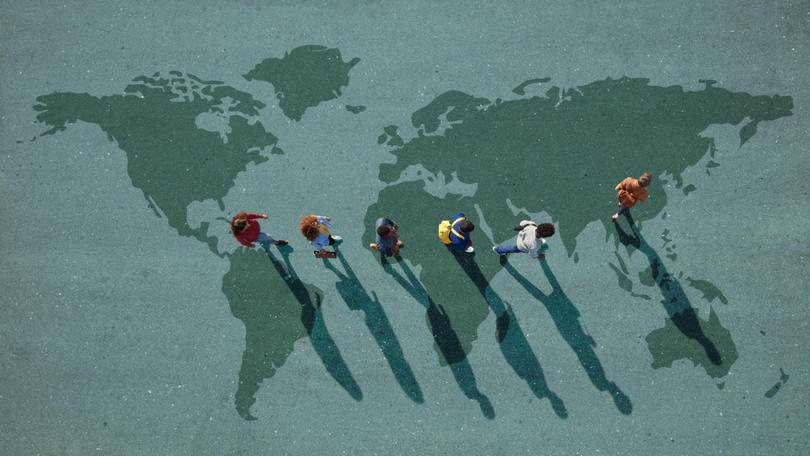Immigration and economies: Breaking down the cost and benefits of new arrivals across the West

The rich world is in the midst of an unprecedented migration boom. Last year 3.3 million more people moved to America than left, almost four times typical levels in the 2010s.
Canada took in 1.9 million immigrants. Britain welcomed 1.2 million people and Australia 740,000.
In each country the number was greater than ever before. For Australia and Canada net migration is more than double pre-COVID levels. In Britain the intake is 3.5 times that of 2019.
Sign up to The Nightly's newsletters.
Get the first look at the digital newspaper, curated daily stories and breaking headlines delivered to your inbox.
By continuing you agree to our Terms and Privacy Policy.Big movements of people have big economic consequences. According to the IMF, the foreign-born labour force in America is 9 per cent higher than at the start of 2019.
In the euro zone, Canada and Britain it is around a fifth higher. America’s immigration surge means that its economy will be 2 per cent larger over the next decade than had been forecast. The influx of workers also helps explain the country’s strong economic growth.
But immigration’s impact goes well beyond an arithmetic effect on GDP -- it extends to inflation, living standards and government budgets. And recent arrivals differ from previous ones: more of them are low-skilled.
Many policymakers have recently argued that migration is helping contain price rises by relieving labour shortages. The list of people to have mentioned or hinted at this association includes Gita Gopinath of the IMF, Jerome Powell of the Federal Reserve and Michele Bullock of the Reserve Bank of Australia.
Yet the evidence is weak and may, in fact, point in the opposite direction. Across the G10 there is little correlation between immigration and slower wage growth. Moreover, there is no doubt immigrants need things as soon as they arrive, boosting demand.
Nowhere is this clearer than in the case of rental housing, which is in short supply across the anglosphere. Research by Goldman Sachs, a bank, suggests that in Australia each 100,000 increase in annual net overseas migration boosts rents by about 1 per cent. A paper by the Bank of Canada in December noted that “the initial rise in immigration that Canada has experienced is more likely inflationary in the near term.”
What about immigration’s impact on economic growth? Although new arrivals are clearly boosting GDP, they appear to be dragging down GDP per person — the yardstick by which economists usually assess living standards. GDP per person has fallen or failed to grow for four consecutive quarters in Australia and seven in Britain. In Canada, where the drop in the measure is most pronounced, output per person fell by 2 per cent in 2023. The picture is similar in Germany, Iceland and New Zealand.
This reflects a shift in the type of immigration. For instance, whereas before the COVID-19 pandemic immigrants to America were as likely to have a bachelor’s degree as their local-born peers, today’s newcomers are more likely to have trekked from poor parts of Latin America and lack the right to legally work. About 2.4 million people entered America last year by illegally crossing the country’s southern border.
Other rich countries have fewer illegal entrants, but they, too, have seen immigration rise most sharply among the low-skilled and low-paid. The proportion of migrants who moved to Australia last year on a skilled-worker visa was a fifth lower than in 2019; many more working backpackers and students received permits.
In Canada 800,000 temporary foreign workers and students accounted for the bulk of last year’s population increase of 3.2 per cent — a growth rate faster than that of almost all countries in sub-Saharan Africa.
Britain left the EU partly on the promise of a smaller and more higher-skilled immigration program, but even there fewer than one in five arrivals last year were skilled workers. The share of permits tied to jobs requiring less than graduate-level training has surged from 11 per cent in 2021 to 62 per cent last year.
Student visas to Britain are up by 70 per cent since 2019, with new ones handed out mostly for master’s degrees at lower-cost, less selective universities. Like many other countries in Europe, Britain has also taken in lots of Ukrainian refugees.
Fielding complaints
Industries that are most vocal about a lack of workers and are hiring lots of migrants, such as agriculture and hospitality, tend to require no qualifications or experience, and offer poor pay and conditions.
Meanwhile, higher-paying sectors that do require qualifications or experience tend not to be benefiting much from the migration surge. Take Canada’s construction industry, which requires skilled tradespeople. Just 5 per cent of employed non-permanent residents work in the sector, below its 8 per cent share of total employment.
Hence the concern that low-skilled migrants are reducing incomes. Yet measures of GDP per person do not tell the whole story.
When a low-skilled immigrant arrives and works for a below-average income, GDP per person falls even if their presence boosts every individual’s income, points out Giovanni Peri of the University of California, Davis. Research by Mr Peri and co-authors shows that local workers are left better off by migration because they take up higher-wage, more productive jobs while leaving physical and poorly paid labour to immigrants.
In effect, immigration creates a more diverse workforce, allowing for more specialisation. People most likely to see their wages fall as a result of migration are those most similar to the migrants, which is typically previous generations of foreign workers.
Some also worry that cheap labour discourages companies from making productivity-boosting investments, although this is wide of the mark for similar reasons. It may be true that high immigration allows, say, a car wash to hire more workers rather than buy a new machine.
Indeed, a study by Ethan Lewis of Dartmouth College found that high immigration to America in the 1980s-90s led plants to adopt less machinery. And in Australia and Canada the capital-to-worker ratio is now falling. But if neither new arrivals nor natives are poorer as a result, what is the problem?
There is one context, though, in which averages matter: the provision of public services. If GDP per person falls, their quality might deteriorate. For this reason, Milton Friedman once remarked that “you cannot simultaneously have free immigration and a welfare state”.
The state is under pressure in much of the rich world. Roads are congested and in countries with public health care, hospital waitlists are long. “Those are not externalities, those are direct effects of new market participants affecting supply and demand,” says Mikal Skuterud of the University of Waterloo.
The crucial question is whether new arrivals on net contribute to or drain from the public coffers. High-skilled types make enormous net fiscal contributions. But for low-skilled workers the question is harder to answer.
In immigrants’ favour is the fact that, because they typically arrive as adults, they do not require public schooling, which is expensive. And they may even prop up public services directly. The largest increase in British work-visa issuance last year, of 157 per cent, was for desperately needed health and care workers.
Potential trouble comes later. Immigrants age and retire. Social-security systems are often progressive, redistributing from rich to poor. Thus a low-earning migrant who claims a government pension — not to mention uses government-provided health care — could end up as a fiscal drag overall. They are most likely to have a positive lifetime effect on the public purse if they leave before they get old.
Quite how this shakes out depends on the country and immigrants in question. A review by America’s National Academies of Sciences, Engineering and Medicine in 2016 found that the estimated 75-year fiscal impact of an immigrant with less than a high-school education, at all levels of government and excluding public goods like national defence, was a negative $115,000 in 2012 dollars. By contrast, a study by Oxford Economics in 2018 found that in Britain about one-third of migrants had left the country ten years after arrival, although it did not distinguish them by skill level.
If the fiscal impact is positive, it will not be felt unless the government invests accordingly. A windfall is no good if public services are allowed to deteriorate anyway, as they have been in Britain, where the government is desperately cutting taxes ahead of an election.
Similarly, if regulations stop infrastructure from expanding to accommodate the arrivals, the migration wave risks provoking a backlash. Nowhere is this more obvious than in the case of housing, where supply is strictly curtailed by excessive regulation in many of the same places now experiencing a migration surge.
Migrants, like natives, need places to live, which increases the imperative to build. Welcoming new arrivals means a lot more than just letting them in.
